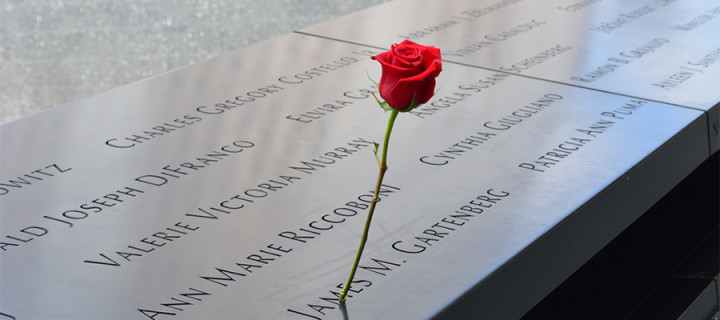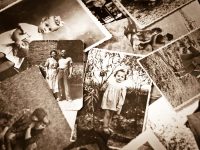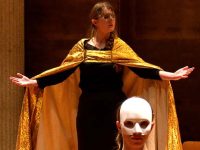Discover New York City – through the eyes of great poets – and Anna. She visited the city that never sleeps with Thomas Austenfeld, Professor of American Literature, and 26 other students of his class. Poems like «The Subway Platform» by Sheck, Lorde’s «A Trip on the Staten Island Ferry» and «Mannahatta» by Whitman guided the class through their big city adventure. Read more about the unique experience of Student Anna Vestermark Caccia, who tells us about 9/11, Central Park and a lot more in her four essays.
Titled «Reflecting Absence», the memorial consists of two massive pools with the largest manmade waterfalls in the United States, located exactly where the iconic Twin Towers of the World Trade Center stood until the sunny morning of September 11, 2001. As the name suggests, these symbolize the emptiness left after what is considered to be the most horrific tragedy in the history of the United States. The waterfalls and reflecting pools are hypnotic, inducing the calm necessary for contemplation and spirituality. The memorial is located in the middle of New York, yet the atmosphere is very peaceful and calm: the sound of water falling muffles the noise of the city, and the hundreds of trees surrounding the pools are a symbol of growth and renewal. The most important of these trees is the so-called Survivor Tree: a majestic pear tree that was found burned and barely alive after the collapse of the Twin Towers. It has quickly become a symbol of hope, strength, and rebirth.
Trapped
The names of the victims (both of the 9/11 attacks and the 1993 bombing) are inscribed on sober and minimalistic bronze plates along the perimeter of the pools. Even though there are 2’983 names on the plates, I recognized a couple of them. I have always been extremely interested in the 9/11 attacks, and I’ve seen a lot of documentaries about the topic. A documentary I find very well made is called «Phone calls from the Towers». Trapped in the Twin Towers, thousands of people tried to call their loved ones and make contact with the outside world. The documentary collects some recorded messages and private calls, which are the only thing the families of the victims have left, as only 300 bodies were recovered after the collapse of the towers. These messages are undeniably difficult to listen to, as many of the callers knew that time was ticking away. The recordings shed light on what really happened inside the towers, but they also reveal something more profound, about the choices people make in their final moments: who to turn to, and what to say. Some sounded desperate, but most tried to sound calm and positive, so as not to scare their relatives even more. Whereas some of the family members in the documentary said they still have the recorded message but don’t listen to it, others said this is a great source of comfort: at least, they will never forget the sound of the voice of their beloved son, daughter, brother, sister, father or mother.
A strong connection
I was very surprised when I read Melissa Harrington Hughes’ name, on a plate located by the south pool. I knew her name would be there, somewhere among hundreds of others, but I didn’t think I would actually find it. She is without a doubt the person from the documentary that I remember the best, and instantly felt connected to her as we share the same love for travelling. As her father recalls, she was so enthusiastic about travelling that she did not want to come home after spending her junior year of college in Italy: she took a job as an au pair in France, and «when I called in May to wish her a happy birthday, they told me she had taken off to Africa. Riding camels in Morocco».
Melissa was in New York for just one day. Aged 31, she was a business executive and had to attend a meeting on the 101st floor of the North Tower on September 11. She would have flown back to California once the meeting was over. After her tower was hit, she managed to talk to her father, but could only leave a message for her husband Sean. Crying, she said «I just wanted to let you know I love you and I’m stuck in this building in New York. There’s lots of smoke and I just wanted you to know that I love you always».
Never forgotten
In the documentary, Melissa’s father seems to have found peace. In his garden, there is a tall and majestic tree. He planted it the week after Melissa was born. The tree grew up, Melissa grew up. The tree grew up to be the biggest tree in the street, and Melissa grew up to be a beautiful, strong woman. The tree is still growing, and Melissa would love it. A person like her, so full of life and passion, will never be forgotten. «I say a little prayer every day, I talk to Melissa. I know she’s there, I know she’s listening», says her father.
The 9/11 Memorial has become a comforting place for the relatives of the victims. It’s a peaceful place where they can talk to their loved one, and leave flowers and flags. As most victims’ remains were never found, it must be comforting to have a place to go to. The memorial fully does justice to the event it is commemorating: the deadliest and most gruesome tragedy in the American history is represented by the most impressive monument in the country.
__________
- Photos: Domitilla Cerclé
- Central Park. Health 1 – Stress 0 - 02.02.2017
- The City of Dreams - 01.02.2017
- 9/11 - 19.01.2017











